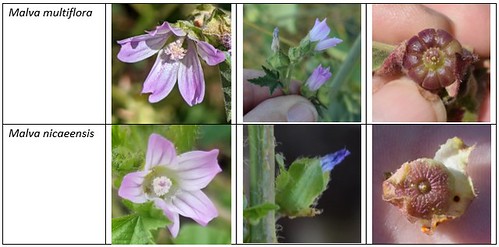How to Identify Malva nicaeensis (Bull Mallow)
Malva nicaeensis is an annual or biennial herb in the Malvaea family known by the common names: bull mallow and French mallow. It is native to Europe, Asia Minor, and the Mediterranean. It has become naturalized in California.
Photo tips:
- If there are multiple plants in the picture, crop your photo to focus on the plant of interest.
The following views are required to identify the species:
** A photo of the entire plant. Is it decumbent or upright? How tall is it?
** A side view of the flower. Are the petals the same length as the calyx? 2x? 6x? Are the epicalyx segments separate or joined? Wide or narrow?
** A close-up of the fruit enclosed in the calyx and one with the calyx peeled back or removed. Is the fruit smooth? Hairy? Wrinkled?- Note that Malva plants without flowers and fruits generally can’t be identified to species and should remain at the genus level (i.e., Malva).
How to identify Malva nicaeensis:
- Height: Grows up to 6 dm (24 in).
- Stems: Erect or ascending to decumbent, prostrate or trailing. Densely hairy.
- Leaves: Round or kidney-shaped, 5 –7 shallow lobes with scalloped margins. The leaf blade is up to 12 cm (4.7 in) wide.
- Flowers: 1-4 small flowers in leaf axils. Flowers are white with faint pink and pink at the apex. Petals are blue when dry. Filament tube is hairy. There are 5 petals that are up to 2x as long as the calyx. Flowering stalks are about the same length as the calyx.
- Calyx/Epicalyx: The calyx grows larger after flowering, enclosing the fruit. The lower half of the epicalyx segments are generally fused to the calyx, not to each other.
- Fruit: Strongly reticulate, mostly glabrous, rarely hairy.
- Habitat: Disturbed places
- Peak Flowering Time: March – June
Similar Species:
- Malva multiflora (Cretan Mallow)
- Malva neglecta (Dwarf Mallow)
How to differentiate M. nicaeensis from M. multiflora:
- M. nicaeensis grows up to 6 dm (2 ft.); M. multiflora can be much taller (up to 10 ft).
- M. nicaeensis has smaller petals (up to 12 mm in length); M. multiflora has petals more than twice as long (up to 30 mm).
- M. nicaeensis petals dry bluish, usually with darker veins; M. multiflora petals dry brownish.
- M. nicaeensis has epicalyx segments that are fused to the calyx, not to each other; M. multiflora has epicalyx segments that are united for about ¼ of their length.
- M. nicaeensis has rugose (wrinkled) mericarps; M. multiflora has smooth mericarps.
References:
- A Guide to the Identification of Wild Mallows (by Jose Potter Butler, William Reinders)
- Calflora: https://www.calflora.org/app/taxon?crn=5353
- Jepson eFlora: https://ucjeps.berkeley.edu/eflora/eflora_display.php?tid=32602eFlora
Keys:
** http://www.efloras.org/florataxon.aspx?flora_id=1&taxon_id=119571
** https://www.inaturalist.org/journal/blue_celery/66193-malva-sylvestris-vs-multiflora-vs-nicaeensis-vs-parviflora-keyiNaturalist:
** https://www.inaturalist.org/taxa/61043-Malva-nicaeensis
** https://www.inaturalist.org/projects/malva-nicaeensis-bull-mallow
** https://www.inaturalist.org/posts/73139-how-to-identify-malva-nicaeensis-bull-mallow





Comentarios
Love this, thanks!
@truthseqr I've had some confusion about this partly because of the Calflora page you reference. Since you wrote this some new photos added there seem to be mislabeled M. multiflora.
@heehaw, I hear your frustration and I share it. There are also some questionable Malva IDs on the Monterey Wildflowers website. I'm not a botanist, so I can't really challenge the professionals who post those pictures.
I find the first reference listed above to be the most credible, so that is the one I use to guide my IDs.
@truthseqr Yes, the guide from NZ has been the best thing for me too!
Agregar un comentario